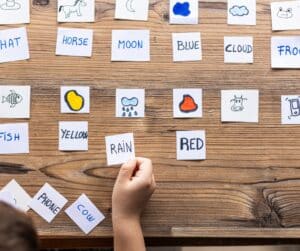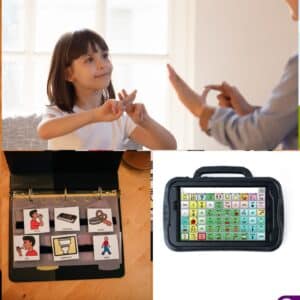Visual aids are essential tools for supporting learning and communication for children with speech, language, and communication challenges. They enhance understanding, improve memory and recall, and provide a means for effective understanding and use of language. In this article, we will answer the question, “How do visual aids support communication and learning?” We will offer examples and ideas for their use.
What Are of Visual Aids?
We all use visual aids every day. A primary example is our frequent use of our cell phones and our computers. Visual aids are tools that use objects, images, symbols, or words to communicate ideas, concepts, or information. They are especially beneficial in communication and educational contexts for children with communication and learning difficulties. Visual aids provide a visual referent for spoken words and abstract concepts.

The Role of Visual Aids
- Enhancing Comprehension
- Visual aids including objects, photographs, pictures, symbols, timers, calendars, schedules, and diagrams make complex concepts visible, more tangible, and easier for children to understand than the spoken word alone.
- Example: Using a visual schedule to help a child understand the sequence of daily activities.
- Improving Focus and Attention
- Bright colors and thoughtfully placed and engaging objects and images can capture the attention and interest of children.
- Example: Color-coded choice boards, communication notebooks, picture schedules, organizational systems, and electronic devices can gain and maintain a child’s engagement and focus.
- Facilitating Communication
- For non-speaking children or those with speech difficulties, Augmentative and Alternative Communication visual aids like sign language, choice boards, communication notebooks, or electronic devices allow them to better understand others and express their needs, wants, feelings, and ideas.
- Example: A child pointing to a picture of a glass of water to indicate thirst.
- Supporting Memory and Recall
- Visual aids can act as memory triggers, helping children to remember, access, and express vocabulary, ideas, and information.
- Example: Associating a specific image with a vocabulary word and pointing to it to respond to a question.
- Encouraging Independence
- Visual aids can guide children in participating in tasks independently, boosting their confidence and self-reliance.
- Examples: Following a step-by-step visual guide for daily tasks and routines like brushing teeth, getting dressed, or completing an assignment.
How to Use Visual Aids
When using visual aids, the following tips may be helpful:

Use Visual Aids Consistently
Using visual aids consistently can help children to understand their function and use them more effectively. Make sure to have visual aids accessible and to use them in a consistent and predictable manner.
Choose Visual Aids that are Clear and Meaningful to the Child
Choosing visual aids that are clear and meaningful to the child can help increase their engagement and motivation to use them. Consider the child’s communication needs, interests, preferences, and developmental level when designing or selecting visual aids.
Use Visual Aids in Natural Contexts
Using visual aids in natural contexts can help children learn how to use language in real-life situations. For example, using a picture of the playground during a conversation about playing outside on the playground can help a child understand the context of the conversation and stimulate their participation in the conversation.

Use Visual Aids in a Functional Manner
Providing opportunities for use of visual aids throughout daily routines and special activities can help children communicate better, learn, and more actively participate in a variety of settings and situations. Consistent use of Augmentative and Alternative Communication systems and strategies, schedules, prompts, and other visual aids at home and in school and other learning environments supports their functional use and benefit to the child.
FAQs
- What are the most effective types of visual aids to use with children struggling to communicate?
- This would depend on the individual strengths and needs of the child. In general, object choices, sign language, photos and other images, communication boards, visual schedules and timers, and other Augmentative and Alternative Communication systems may be helpful to explore.
- Can visual aids help children with dyslexia?
- Yes, tools like colored overlays and mind maps can assist in reading and organizing thoughts.
- How do I use visual aids with my child to help them communicate and learn?
- It really depends on what you ae trying to accomplish by using the visual aids. You can use online resources such as those provided below. Collaborate with your child’s speech-language pathologist and education team to create the most effective personalized aids for your child.
- Can visual aids be used for group learning?
- Yes, visual aids are effectively used in most group learning settings.
Additional Resources
- Using-Visuals-to-Support-Communication.pdf
- How Parents Can Help Children With Speech and Language Disorders in Virtual and Modified In-Person Classroom Settings (asha.org)
- Use of Visual Supports-Down syndome
- Visual supports (autism.org.uk)
- Visual Strategies with Boardmaker Online (goboardmaker.com)
- Do2Learn: Educational Resources for Special Needs
Summary/Conclusion
Visual aids such as objects, photographs, pictures, schedules, printed words, books, sign language, and Augmentative and Alternative Communicaton tools play a critical role in supporting communication development and learning for individuals with developmental delays. By using visual aids consistently and functionally, choosing visual aids that are meaningful and easy to interpret for the child, using visual aids in natural contexts, and providing access and consistent opportunities for visual aid use, parents can support their child’s communication development in immeasurable ways.




0 Comments